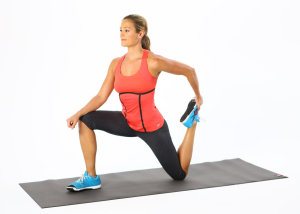Hips Don’t Lie: 4 Drills to Unlock Your Stiff Hips
The following information has been kindly borrowed from the following webpage: http://breakingmuscle.com/mobility-recovery/hips-don-t-lie-4-drills-to-unlock-your-stiff-hips
Hips Don’t Lie: 4 Drills to Unlock Your Stiff Hips
The hip joint is one of the most mobile in the body, so why can’t you move yours? Most people I know waste their time with:
- Foam rolling
- Couch stretching, and
- Lounging in pigeon pose
All without making much progress. And that’s a real shame.
Your hips drive the vast majority of your movements, holding the key to everything from walking to squatting. If they lose range of motion, you’re bound to compensate somewhere else – cue low back and knee pain. In this article I’ll share some of the most effective tools for unlocking stiff hips and regaining your mobility.
Mapping the Territory
First things first. Let’s clarify what we mean by “hips.” This is a loaded word for a lot of folks, and too many people go through life with zero clue what and where their hips actually are. Try this. Slide your hand up and down along the outside of your leg. Feel that bony bump? Yeah, that’s not your hip.
But it is a useful landmark. Put your thumb there, and bring your hand flat along the front of your leg with the fingers pointing in. Now lift your leg the tiniest bit. Feel that bulge of muscle under your fingers? That’s where your hip is. Your hip is where the head of the femur meets the acetabulum, the proverbial “socket.” This understanding of the hip is tremendously useful when trying to organize your hip movement.
Now that we’ve cleared that up, let’s figure out how to unlock those bad boys.
Hip Rotations
Remember that “ball and socket” idea? That’s a biggie. Your hips love circular movement. It’s what they’re built for. Hip rotations teach your hips how to navigate that three-dimensional space and regain control over that range of motion. Here’s how it’s done:
- Start on hands and knees
- Maintain spinal and pelvic neutrality
- Bring your knee forward
- Take it out to the side along an arc
- Reach it around behind into extension
- Reverse, moving slowly and with control
- Revel in your juicy hips
Aim for 5 slow, controlled rotations in each direction on each hip.
90/90 Floss
Now that we’ve created some space within the joint, it’s time to put it to work. I was introduced to this movement by Ben Medder, and it has been a total game changer for me. Find your way into a 90/90 position, with 90 degree angles at the hips and knees. You may want to put a tennis ball under your lead knee for tactile reinforcement. Think of crushing the tennis ball as you pivot on your trail toe to open the hip. Cramping is expected.
More often than not those cramps are rooted in your nervous system, not your electrolyte balance. When you put your body in unfamiliar positions, occasionally the nervous system freaks out and engages every muscle it can in a hunt for stability. It’s a protective mechanism. Breathe, and ride it out. This is a learning opportunity.
Wall Hinge
Hello hammies. Let’s explore hip flexion a bit, using a wall as external feedback. You’ll begin with your back to a wall, about a foot away. Get heavy in your heels, and think about reaching the sit bones back toward the wall. Get tall through the spine to avoid compensatory rounding in the back. If you can reach the wall without falling into the wall, scoot a tiny bit forward and repeat. You’re on a hunt for the end range of your balance. If you fall into the wall, scoot backwards and try again. Aim for 8-12 hinges at your end range.
Chair Smash
I saved the best for last. This is an upgraded version of the couch stretch. Here’s what to do:
- Pick up your favorite chair
- Break it.
Seriously it’s time to get out of the damn chair. A handful of stretches and half an hour of movement won’t make up for 8-14 hours in a chair all day. I wish it was more complex. But if you want to unlock stiff hips, you simply have to get out of the chair more often. I outline a few useful alternatives here.











Comments
Comment Guidelines: The SportsTG Network is made up of players, families and passionate sports followers like you who have a strong opinion about sport. That's great - we want you to have your say and share your thoughts with the world. However, we have a few rules that you must follow to keep it fun for all. Please don't be rude, abusive, swear or vilify others. Apart from some pretty serious sport sanctions, we also can ban you and report you if things get out of hand. So play fair and have fun, and thanks for your contribution.